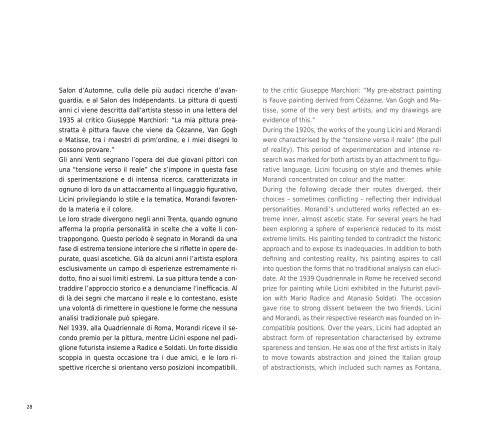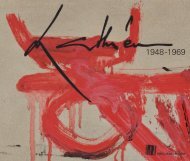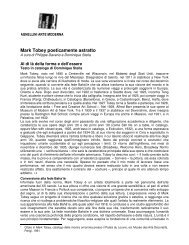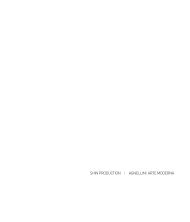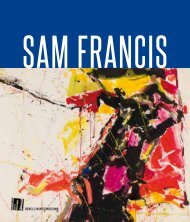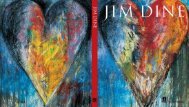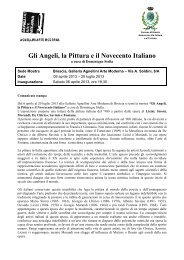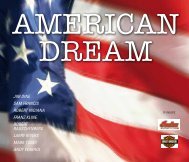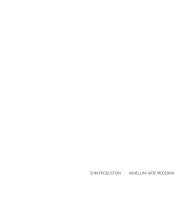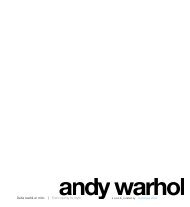Gli Angeli, la Pittura e il Novecento Italiano - Galleria Agnellini Arte ...
Gli Angeli, la Pittura e il Novecento Italiano - Galleria Agnellini Arte ...
Gli Angeli, la Pittura e il Novecento Italiano - Galleria Agnellini Arte ...
Create successful ePaper yourself
Turn your PDF publications into a flip-book with our unique Google optimized e-Paper software.
28<br />
Salon d’Automne, cul<strong>la</strong> delle più audaci ricerche d’avanguardia,<br />
e al Salon des Indépendants. La pittura di questi<br />
anni ci viene descritta dall’artista stesso in una lettera del<br />
1935 al critico Giuseppe Marchiori: “La mia pittura preastratta<br />
è pittura fauve che viene da Cézanne, Van Gogh<br />
e Matisse, tra i maestri di prim’ordine, e i miei disegni lo<br />
possono provare.”<br />
<strong>Gli</strong> anni Venti segnano l’opera dei due giovani pittori con<br />
una “tensione verso <strong>il</strong> reale” che s’impone in questa fase<br />
di sperimentazione e di intensa ricerca, caratterizzata in<br />
ognuno di loro da un attaccamento al linguaggio figurativo,<br />
Licini priv<strong>il</strong>egiando lo st<strong>il</strong>e e <strong>la</strong> tematica, Morandi favorendo<br />
<strong>la</strong> materia e <strong>il</strong> colore.<br />
Le loro strade divergono negli anni Trenta, quando ognuno<br />
afferma <strong>la</strong> propria personalità in scelte che a volte li contrappongono.<br />
Questo periodo è segnato in Morandi da una<br />
fase di estrema tensione interiore che si riflette in opere depurate,<br />
quasi ascetiche. Già da alcuni anni l’artista esplora<br />
esclusivamente un campo di esperienze estremamente ridotto,<br />
fino ai suoi limiti estremi. La sua pittura tende a contraddire<br />
l’approccio storico e a denunciarne l’inefficacia. Al<br />
di là dei segni che marcano <strong>il</strong> reale e lo contestano, esiste<br />
una volontà di rimettere in questione le forme che nessuna<br />
analisi tradizionale può spiegare.<br />
Nel 1939, al<strong>la</strong> Quadriennale di Roma, Morandi riceve <strong>il</strong> secondo<br />
premio per <strong>la</strong> pittura, mentre Licini espone nel padiglione<br />
futurista insieme a Radice e Soldati. Un forte dissidio<br />
scoppia in questa occasione tra i due amici, e le loro rispettive<br />
ricerche si orientano verso posizioni incompatib<strong>il</strong>i.<br />
to the critic Giuseppe Marchiori: “My pre-abstract painting<br />
is Fauve painting derived from Cézanne, Van Gogh and Matisse,<br />
some of the very best artists, and my drawings are<br />
evidence of this.”<br />
During the 1920s, the works of the young Licini and Morandi<br />
were characterised by the “tensione verso <strong>il</strong> reale” (the pull<br />
of reality). This period of experimentation and intense research<br />
was marked for both artists by an attachment to figurative<br />
<strong>la</strong>nguage, Licini focusing on style and themes wh<strong>il</strong>e<br />
Morandi concentrated on colour and the matter.<br />
During the following decade their routes diverged, their<br />
choices – sometimes conflicting – reflecting their individual<br />
personalities. Morandi’s uncluttered works reflected an extreme<br />
inner, almost ascetic state. For several years he had<br />
been exploring a sphere of experience reduced to its most<br />
extreme limits. His painting tended to contradict the historic<br />
approach and to expose its inadequacies. In addition to both<br />
defining and contesting reality, his painting aspires to call<br />
into question the forms that no traditional analysis can elucidate.<br />
At the 1939 Quadriennale in Rome he received second<br />
prize for painting wh<strong>il</strong>e Licini exhibited in the Futurist pav<strong>il</strong>ion<br />
with Mario Radice and Atanasio Soldati. The occasion<br />
gave rise to strong dissent between the two friends, Licini<br />
and Morandi, as their respective research was founded on incompatible<br />
positions. Over the years, Licini had adopted an<br />
abstract form of representation characterised by extreme<br />
spareness and tension. He was one of the first artists in Italy<br />
to move towards abstraction and joined the Italian group<br />
of abstractionists, which included such names as Fontana,


